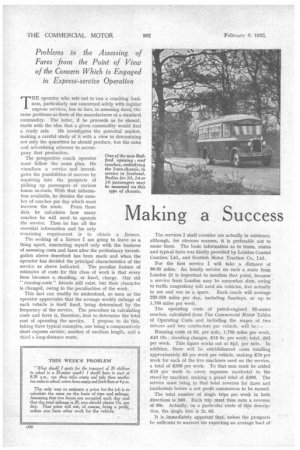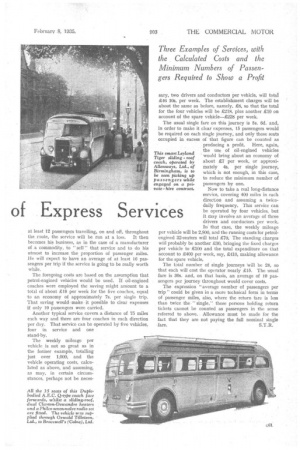Making a Success
Page 122

Page 123

If you've noticed an error in this article please click here to report it so we can fix it.
of Express LiQervices
THE operator who sets out to run a coaching business, particularly one concerned solely with regular express services, has to fate, in assessing fares, the same problems as those of the manufacturer of a standard commodity. The latter, if he proceeds as he should, starts with the idea that a given commodity would find
a ready sale. He investigates the potential market, making a careful study of it with a view to determining not only the quantities he should produce, but the sales and advertising schemes to accompany that production.
The prospective coach operator must follow the same plan. He visualizes a service and investigates the possibilities, of success by inquiring into the prospects of picking up passengers at various towns en route. With that information available, he decides the number of coaches per day which must traverse the route. From those data he calculates how many coaches he will need to operate the service. Then he has all the essential information and his only remaining requirement is to obtain a licence.
The seeking of a licence I am going to leave as a thing apart, concerning myself only with the business of assessing costs and fares after the preliminary investigation above described has been made and when the operator has decided the principal characteristics of the service as above indicated. The peculiar feature of estimates of costs for this class of work is that every item becomes a standing, or fixed, charge. Our old " running-costs " friends still exist, but their character is changed, owing to the peculiarities of the work.
This fact can readily be understood, so soon as the operator appreciates that the average weekly mileage of each vehicle is itself fixed, being determined by the frequency of the service. The procedure in calculating costs and fares is, therefore, first to determine the total cost of operating the service. I propose to do this, taking three typical examples, one being a comparatively short express service; another of medium length, and a third a long-distance route. One of the new Bed.. ford opening roof coaches, embodying the 3-ton chassis, in service in Scotland. Bodies for 20, 24 or 26 passengers may be mounted on this
type of chassis. The services I shall consider are actually in existence, although, for obvious reasons, it is preferable not to name them. The basic information as to times, routes and typical fares was kindly provided by London Coastal Coaches, Ltd., and Scottish Motor Traction Co., Ltd.
For the first service I will take a distance of 30-35 miles. An hourly service on such a route from London (it is important to mention that point, because-a service from London may be somewhat slow, owing to traffic congestion) will need six vehicles, five actually in use and one as a, spare. Each coach will average 20-250 miles per day, including Sundays, or up to 1,750 miles per week.
The operating costs of petrol-engined 32-seater coaches, calculated from The Commercial Motor Tables of Operating Costs and including the wages of two drivers and two conductors per vehicle, will be :— Running costs at 6d. per mile, 1,750 miles per week, 243 15s.; standing charges, £18 5s. per week; total, £62 per week. This figure works out at 8-0. per mile. In addition, there will be establishment costs totalling approximately 28 per week per vehicle, making 270 per week for each of the five machines used on the service, a total of £350 per week. To that sum must be added 210 per week to cover expenses incidental to the stand-by machine; making a grand total of .2360. The service must bring in that total revenue for fares and incidentals before a net profit commences to be earned.
The total number of single trips per week in both directions is 240. Each trip must thus earn a revenue of 30s. Actually, on a particular, route of this description, the single fare is 2s. 6d.
It is immediately apparent that, unless the prospects be sufficient to warrant his expecting an average load of at least 12 passengers travelling, on and off, throughout the route, the service will be run at a loss. It then becomes his business, as in the case of a manufacturer of .a commodity, to "sell" that service and to do his utmost to increase the proportion of passenger miles. He will expect to have an average of at least 16 passengers per trip if the service is going to be really worth while.
The foregoing costs are based on the assumption that petrol-engined vehicles would be used. If oil-engined coaches were employed the saving might amount to a total of about £18 per week for the five coaches, equal to an economy of approximately 7s. per single trip. That saving wouldmake it possible to clear expenses if only 10 passengers were carried.
Another typical service covers a distance of 75 miles each way and there are four coaches in each direction per day. That service can be operated by five vehicles, four in service and one stand-by.
The weekly mileage per vehicle is not so great as in the former example, totalling just over 1,000, and the vehicle operating costs, calcu lated as above, and assuming, as may, in certain circum stances, perhaps not be neces sary, two drivers and conductors per vehicle, will total 246 10s. per week. The establishment charges will be about the same as before, namely, £8, so that the total for the four vehicles will be £218, plus another £10 on account of the spare vehic1e—£228 per week.
The usual single fare on this journey is 5s. 6c1; and, in order to make it clear.expenses, 15 passengers would be required on each single journey, and only those seats occupied in. excess of that figure can be counted as
producing a profit. Here, again, the use of oil-engined vehicles would bring about an economy of about £7 per week, or approximately 4s. per single journey, which is not enough, in this case, to reduce the minimum number of passengers by one.
Now to take a real long-distance service, covering 400 miles in each direct-on and assuming a twicedaily frequency. This service can be operated by four vehicles, but It may involve an average of three drivers and conductors per week. In that case, the weekly mileage per vehicle will be 2,800, and the running costs for petrolengined 32-seaters will total 470. The standing. charges will probably be another £30, bringing the fixed charges per vehicle to£100 and the total expenditure on that account to £400 per week, say, £410, making allowance for the spare vehicle.
The total number of single journeys Will be 28, so that each will cost the operator nearly £.15. The usual fare is 30s. and, on that basis, an average of 10 passengers per journey throughout would cover costs.
The expression "average number of passengers per trip" could be givenin a more technical form' in terms of passenger miles, also, where the return fare is less than twice the" single," those persons holding return tickets cannot be .counted as passengers in the sense referred to above, Allowance must be made for the fact that they are not paying the full nominal single fare. S.T.R.














































































































































































